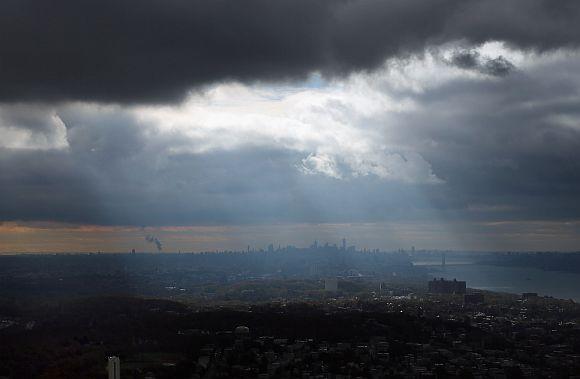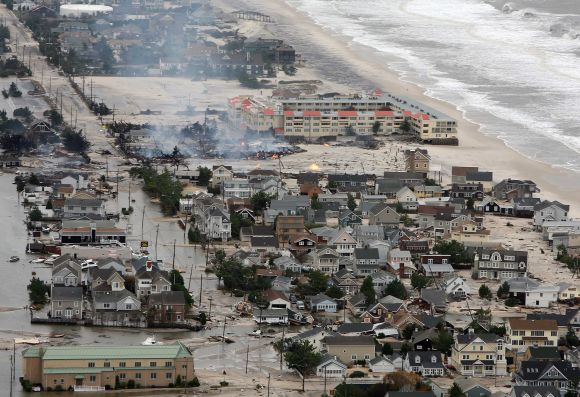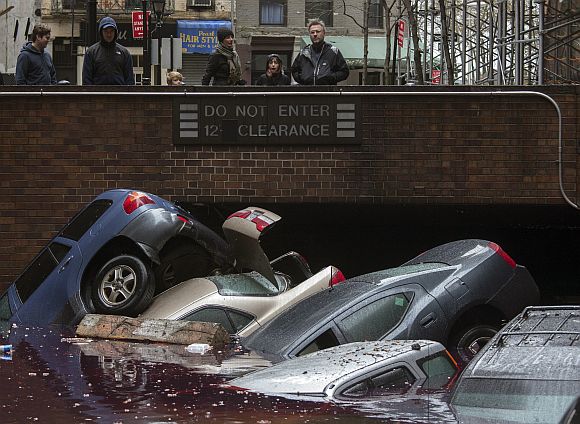Photographs: Mario Tama/Getty Images Aseem Chhabra
Aseem Chhabra flew half way around the world from New Delhi to get back to his home in the Sunnyside neighbourhood in Queens to witness the imminent of wrath and fury of Hurricane Sandy with his fellow New Yorkers.
At a lunch on Sunday afternoon at New Delhi's India International Centre, a group of friends warned me about the difficult journey ahead. They wanted me to stay back in the national capital for a few more days, instead of ending my month-long work and vacation trip to Japan and India.
Everyone had read about the ominous threats from the massive Hurricane Sandy that was set to hit the northeastern coast of the United States. New York City's schools were expected to close on Monday, and there were reports that the region's three major airports, as well as the subway system had shut down.
But I wanted to be back home. I was in New York in 2001 during the September 11 terrorist attacks, the blackout of August 2003, the December 2005 transit workers' strike, the brownout in parts of Queens in July 2006 and even the mild Hurricane Irene in August 2011.
During each of these disasters, New Yorkers had become a one large family, caring for their neighbours and those who had suffered personal losses. A friend put me up on his couch in 2003 and then again in 2006, because I was stuck in the city and relatively far from my apartment. So, I wanted to be home to witness the imminent wrath and fury of Sandy with my fellow New Yorkers.
Obviously I could not have predicted what lay ahead in my immediate future.
Please ...
Sandy Diary: 'I just wanted to be back home'
Photographs: Toru Hanai/Reuters
My trip back to New York included taking a connecting flight from Tokyo. I boarded the flight from Delhi. The Japan Airlines ground crew even gave me a boarding card for the Tokyo-New York flight, along with assigning me an aisle seat.
My first shock was at Tokyo's Narita Airport when a JAL representative informed me at 7 am that my flight to New York had indeed been cancelled. JAL would pay for my hotel room for one night.
There was a mixed sense of disappointment and thrill. I could not be in New York to witness Sandy, but I suddenly had a partially paid one-day unplanned vacation in Tokyo.
That one-day vacation became a two-day affair. I am not complaining. I made a new friend in the lobby of the dumpy Marroad International Hotel near the airport. My new friend Brandon Barton is a resident of Brooklyn and he once worked as a manager at the now-closed Tabla restaurant.
We reminisced about the Tabla menu and bonded during the two days we spent sightseeing in Tokyo -- from the hip Shibuya district to the Tsukiji Fish Market, where we had an 8.30 am sushi breakfast.
We visited the Park Hyatt Hotel where Sofia Coppola shot Lost in Translation and also took pictures outside the Michelin 3-star Sukiyabashi Jiro restaurant in the Ginza area where its 86-year-old owner Jiro Ono serves a 20-piece sushi meal for 30,000 Yen and was featured in the film Jiro Dreams of Sushi.
Please ...
Sandy Diary: 'I just wanted to be back home'
Image: The New Jersey seashore after Sandy struckPhotographs: Courtesy: New Jersey Governor's Office
But all the while our hearts and minds were focussed on what was happening in New York. We made stops at the Apple store to check the Internet and get the latest news about Sandy, and e-mailed friends and family to hear from them.
I stared with disbelief at images people had posted on Twitter -- flooded subway stations, burning homes in Breezy Point in Queens.
On Monday night, I looked around in the cheesy hotel's dining room, overlooking planes landing and taking off. There were many people like me -- of different colours and nationalities, all of us orphans of the storm, abandoned in some strange corner of the globe, not being allowed to go home, as a monster storm ravaged our world and lives.
On Wednesday morning at 6 am, as we stood in the line at Narita airport hoping to take a flight to New York, a person standing behind me joked that may be we should ask FEMA for assistance.
In the line, as we got one bad news after another -- the flight to New York may not leave, other JAL flights to the US appeared to be full and there was no guarantee that the airline would pay for another night in a hotel -- I made connections with other New Yorkers who had been abandoned in Tokyo.
Most were returning from vacations in Bali, Vietnam, Cambodia, Singapore, Hong Kong and some had not been given free accommodation by the airline. I even ran into a good New York friend Chuck Edwards who was returning from a vacation in Cambodia and Bali.
Please ...
Sandy Diary: 'I just wanted to be back home'
Photographs: Andrew Kelly/Reuters
It was a messy situation as we pushed to talk to the polite JAL representatives. Most spoke halting and limited English and seemed a bit tired of dealing with foreigners making urgent demands.
A group of us had our names added as standby passengers to Boston and three hours later many of us made it to that flight. I know Boston well, having lived there for two years.
New York City seemed very close to Boston. Otherwise the option was to spend a couple of more days in Tokyo and hope that JFK airport would open up all its damaged runways.
At Boston's Logan airport we became a group of six -- all strangers, other that Brandon and Chuck. After much deliberation we rented two cars. My car included an 80-year-old woman Ellie who was returning from a vacation in Vietnam with her daughter, who lives in Washington, DC and Chris, a twenty-something-year-old English instructor in Korea who was heading to visit his parents in Greenwich, Connecticut
We talked about what we did in Tokyo for a couple of days, sharing some details of our personal lives and concerns of what surprises Sandy had left for us. We saw many uprooted trees along the Massachusetts Turnpike.
Please ...
Sandy Diary: 'I just wanted to be back home'
Image: Residents stand over vehicles which were submerged in a parking structure in the financial district of Lower ManhattanPhotographs: Adrees Latif/Reuters
We heard National Public Radio and the reports there gave us an immediate sense of the disaster. Later we were shocked to see so many giant uprooted trees close to Chris' home in Greenwich. His parents and neighbours had no electricity for the third day.
I am fortunate -- my Sunnyside neighbourhood in Queens got a lot of rain and wind, but it never lost electricity and water. In the 24-hour grocery store close to my apartment building the shelves were somewhat empty. There had been no fresh food delivery for two days, but there was plenty of bottled water.
The only problem I have is that the subways are down. The number 7 train, half a block from where I live, passes through the tunnels under the East River. And those tunnels are flooded. Leaving home and heading to Manhattan is going to be a problem for a while.
I know my situation in Queens is far better than that of the hundreds of thousands downtown Manhattan residents who have no power, Internet and hot water, or the millions of New Jerseyites whose homes have been destroyed or flooded. The city is divided in a different sort of a 'haves and have-nots.'
But I am glad to be home. A friend in India reminded me of a dialogue in the recent indie hit film Beasts of the Southern Wild. It goes like this: 'Whatever it is, wherever it is, you want to go back to that place called home!'






article